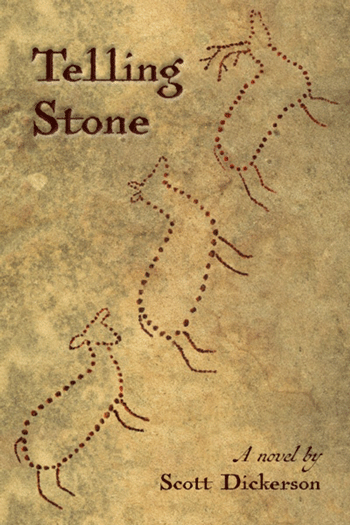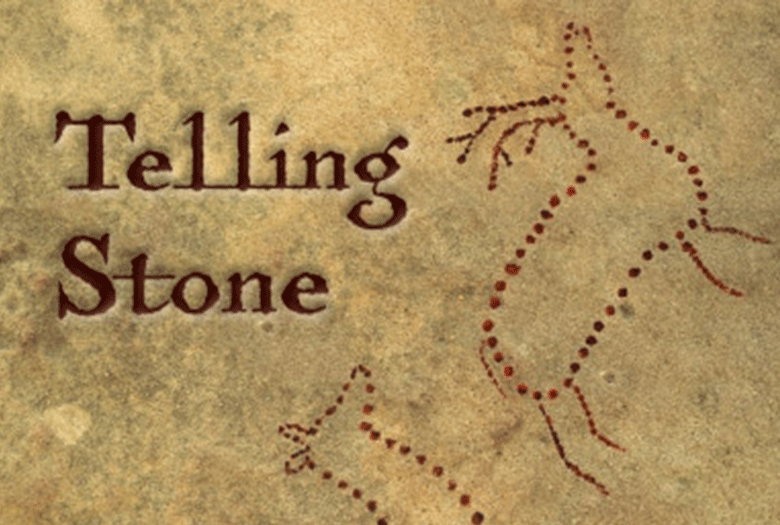Telling Stone
Maine Authors Publishing (2022)
Who were the first artists and why did they make art? Those are the central questions that prompted Scott Dickerson to write Telling Stone. Set in paleolithic times, the novel tells the story of 20-year-old Okyo, a “man apart” in his band of people, the Santanda, and how he searches for meaning through carving and painting—and seeks love—a hearthmate—from cave to cave.
The Santanda people divide the year between two caves, Greenhearths in the greenseason and Snowhearths in winter. They are hunters and gatherers, living mostly on deer and fish. We follow their lives, with Okyo providing asides—short italicized passages—that reflect on the day-to-day goings-on, be it the power of the art he makes or tension with Kocho, his rival.
Okyo uses his art to pay tribute to the creatures that sustain his band. A carver at the beginning, he learns how to paint from Pitto who joined the Santanda from another tribe. Their mediums include red ocher and charcoal. They paint “seeking power.”
The novel is timely: recent research on cave drawings has uncovered new theories about how the early artists worked.
Dickerson creates a poetic vocabulary for his fictional clan. His compound nouns include words for various animals—tallanterlered (red deer), silversides (salmon)—as well as various plants, tools, ceremonies, and body parts. There is a glossary at the end, but turning to it will take some of the fun out of figuring out the meaning of a particular word. What’s a lifedrumcave? Fireseed? Orangebelliedflash? Tuskedgrunt? Succulents? Snowpissrock? Talkswithtail?
Telling Stone is no Clan of the Cave Bear or One Million B.C. Where that book and that movie heightened the drama of early ancestors to the nth degree, Dickerson takes a quieter route, the narrative nearly violence-free. That said, there’s a close encounter with a bear—an alleater—several hunting scenes, and a couple of fairly steamy sexual encounters.

Some elements of the story seem out of place, too modern in concept. Would women of that ancient time discuss masturbation? Maybe. Would a cave artist muse, “If you have to talk about your painting, what you have painted does not tell its story”? Perhaps. On the other hand, the story of how “sharpness came to be” or Okyo’s wondering at how fish eat their young and how this relates to his consuming his childhood are memorable.
The novel is timely: recent research on cave drawings has uncovered new theories about how the early artists worked. One article is titled “For Over 20,000 Years, Neanderthals Spat Paint On This Stalagmite” while another declares “Cave Paintings Show Neanderthals Were Artists.”
Werner Herzog’s film Cave of Forgotten Dreams has spurred additional interest as has commentary from the likes of critic Jerry Saltz who urges pilgrimages to see cave art.
Dickerson earned a master of philosophy in human ecology degree from College of the Atlantic in 1995 before becoming director of the Coastal Mountains Land Trust. You sense his COA ties through his sensitivity to the ecology of this long-ago world (and the tribal gatherings recall his alma mater’s All College Meetings).
In Telling Stone’s afterword Dickerson notes how none of us can know “how these people lived, loved, revered, feared, celebrated, honored, or in any other way engaged with other people, animals, or the entities of their imagination.” As he stated during a book talk in COA’s Davis Center for Human Ecology in January, Telling Stone is speculative fiction. As such, it engages you in wondering about the motives of the first artist—to record, to venerate, to find joy? These questions keep you reading.
Carl Little lives on Mount Desert Island.





